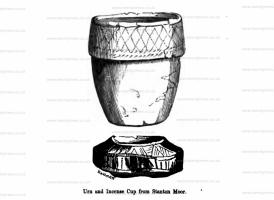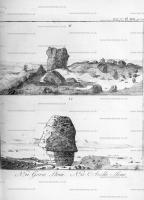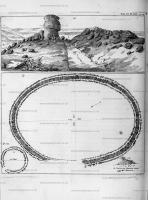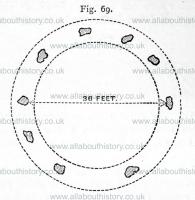Text this colour links to Pages. Text this colour links to Family Trees. Text this colour are links that are disabled for Guests.
Place the mouse over images to see a larger image. Click on paintings to see the painter's Biography Page. Mouse over links for a preview. Move the mouse off the painting or link to close the popup.
Stanton Moor, Derbyshire is in Derbyshire Dales.

Archaeologia Volume 6 Section XIII. An account of some Druidical Remains on Stanton and Hartle Moor in the Peak, Derbyshire. By Hayman Rooke (age 57), Esq. Read April 6, 1780.

Archaeologia Volume 8 Section III. 2nd November 1785. Observations by the Rev. Mr. Pegge (age 80) on the Stanton-Moor Urns, and Druidical Temple [Map]. In a Letter to Major Rooke (age 62). Read November 2,. 1785;

Vestiges of the Antiquities of Derbyshire. Towards the north-east end of Stanton Moor is a small Druid circle, inclosed with a vallum of earth and stones, not raised above two feet; within this at the west end was a little barrow [Map]; opened about the year 1787, by Mr. Rooke; this barrow was about six feet in diameter, and but slightly higher than the surrounding field. The Major here found three large urns of coarse clay, placed in a row, about eight inches from each other. They rested upon stones a little below the natural soil, within twelve or fourteen inches of the top of the barrow.
Seing so near the surface the heavy rains and the roots of fern and gorse which had so penetrated the urns, made it difficult to move them without their falling to pieces; in taking out of one of them the ashes and bones which it contained, the Major found at the bottom, a smaller urn, also full of burned bones, covered with a piece of clay of a circular form.
In 1799 Mr. White Watson, of Bakewell, procured several urns from tumuli, upon Stanton Moor, one of which with an incense cup found at the same place is here engraved. From the information of the person employed, it appears that three were frequently found in one barrow, arranged in a triangular form. Several other barrows were opened upon Stanton Moor by the Rev. Bache Thornhill, in which were discovered only such interments as had undergone cremation, and in most cases the ashes had been gathered together and placed within urns; the remains of three varieties of these vessels, with their contents, were presented by William Pole Thornhill, Esq., of Stanton, to the writer. Amongst the calcined bones were two pins, one of bone, the other of bronze, a few pieces of flint, and a large pebble with a vitrified surface resulting from the strong degree of heat to which in common with the other articles, it had been exposed.
Andle Stone is also in Peak District Standing Stones.
Andle Stone [Map]. A large boulder on Stanton Moor in Derbyshire.

Archaeologia Volume 6 Section XIII. Plate XVII. N° II. is a view of a stone called Gorse Stone [Map], with Cat Stone at a distance marked I. This name is undoubtedly derived from a British word gorsed dau (setting aloft). Doctor Borlace says, in his Antiquities of Cornwall, that the Druids had places of elevation "called gorsed dau; in some places they were made of earth, and sometimes they were upon high rocks, from whence they used to pronounce their decrees." Now no place seems to be better calculated for that purpose, or for their inaugurations, than these stones; the other, which is the largest of the three, is called Heart Stone [Map], and measures eighty-three feet in circumference.
N° 12. is a stone of a very singular fhape, called Andle Stone [Map]. It stands by itself on Stanton Moor, about a quarter of a mile north of Rowter; it seems to have been formed by art, and might probably have been a rock idol.

Archaeologia Volume 6 Section XIII. Plate XVI. N° 9. is a plan drawn by a scale of 40 feet to an inch of a circular British work called Castle Ring [Map], about two hundred yards north from the above mentioned temple, and a quarter of a mile west of the little valley which separates Hartle Moor from Stanton Moor. It has a deep ditch and double vallum; the entrance is very visible on the south east side, where part of the vallum has been levelled by the plough. The diameter from north-east to south-west is one hundred and forty-three feet, from south-east to north-west one hundred and fixty-five feet. As no coins or Roman utensils have been found near it, there seems to be sufficient grounds to suppose it to be a British and not a Roman encampment. It has been thought by some to have been a Danish work; certain it is that the Danes secured themselves for some time in Derby, after they had driven out the Saxons; but as this place is a great distance from that town, from its vicinity to many Druidical remains I should rather suppose it to be British.
N° 10. is a view of Cats Stones [Map]. At the east side of Stanton Moor are three very remarkable stones; they stand at the edge of a declivity looking over Darleydale, and about a quarter of a mile from each other in a north and south direction. They have at a distance much the appearance of towers: that to the south is called Cats Stone, and has a road leading to it cut through a surface of loose stones and rock: this was evidently intended as an approach to the stone, where it ends, and meets a precipice.

Archaeologia Volume 6 Section XIII. Plate XVI. N° 9. is a plan drawn by a scale of 40 feet to an inch of a circular British work called Castle Ring [Map], about two hundred yards north from the above mentioned temple, and a quarter of a mile west of the little valley which separates Hartle Moor from Stanton Moor. It has a deep ditch and double vallum; the entrance is very visible on the south east side, where part of the vallum has been levelled by the plough. The diameter from north-east to south-west is one hundred and forty-three feet, from south-east to north-west one hundred and fixty-five feet. As no coins or Roman utensils have been found near it, there seems to be sufficient grounds to suppose it to be a British and not a Roman encampment. It has been thought by some to have been a Danish work; certain it is that the Danes secured themselves for some time in Derby, after they had driven out the Saxons; but as this place is a great distance from that town, from its vicinity to many Druidical remains I should rather suppose it to be British.
N° 10. is a view of Cats Stones [Map]. At the east side of Stanton Moor are three very remarkable stones; they stand at the edge of a declivity looking over Darleydale, and about a quarter of a mile from each other in a north and south direction. They have at a distance much the appearance of towers: that to the south is called Cats Stone, and has a road leading to it cut through a surface of loose stones and rock: this was evidently intended as an approach to the stone, where it ends, and meets a precipice.
Doll Tor is also in Peak District Stone Circles.
Ten Years' Digging. On the 10th of April, 1852, in company with Mr. Carrington, and Mr. Glover, the Historian of the County of Derby, I walked over a considerable part of Stanton Moor, in order to survey the scene of former discoveries, and to examine the existing remains of Tumuli, Rocking Stones, &c., upon this interesting tract of land. On passing over the brow of the hill, near the Andle Stone [Map], we noticed a small circle [Doll Tor [Map]] of six stones, four of which retained their upright position, whilst two were prostrate, the diameter being about twenty feet; in the interior were a few small pieces of pottery, and some calcined bones that had been scratched up by rabbits, the sight of which caused us to set to work with our pocket-knives, when finding the remains to become more plentiful, we borrowed a hack and spade from the adjoining farm, and cleared a considerable space in the centre of the enclosure, where a grave had been dug for the reception of three or four cinerary urns, and as many "incense cups;" all which had been emptied of their calcined contents, and broken by former diggers, who, however, left the fragments. These having since been joined, as far as possible, afford a tolerable idea of the original shape and ornamentation of the vessels, about which there is a little peculiarity, the outline of the large urns being more straight sided than common in this part of England; they approach the form of a common red garden flower-pot, and are sparingly decorated with the everlasting chevron. Most of the urns of this type hitherto discovered, have been exhumed in the South-West of England, the Deverell Barrow having afforded several specimens.
All About History Books
The Deeds of King Henry V, or in Latin Henrici Quinti, Angliæ Regis, Gesta, is a first-hand account of the Agincourt Campaign, and subsequent events to his death in 1422. The author of the first part was a Chaplain in King Henry's retinue who was present from King Henry's departure at Southampton in 1415, at the siege of Harfleur, the battle of Agincourt, and the celebrations on King Henry's return to London. The second part, by another writer, relates the events that took place including the negotiations at Troye, Henry's marriage and his death in 1422.
Available at Amazon as eBook or Paperback.

Archaeologia Volume 6 Section XIII. Plate XVII. N° II. is a view of a stone called Gorse Stone [Map], with Cat Stone at a distance marked I. This name is undoubtedly derived from a British word gorsed dau (setting aloft). Doctor Borlace says, in his Antiquities of Cornwall, that the Druids had places of elevation "called gorsed dau; in some places they were made of earth, and sometimes they were upon high rocks, from whence they used to pronounce their decrees." Now no place seems to be better calculated for that purpose, or for their inaugurations, than these stones; the other, which is the largest of the three, is called Heart Stone [Map], and measures eighty-three feet in circumference.
N° 12. is a stone of a very singular fhape, called Andle Stone [Map]. It stands by itself on Stanton Moor, about a quarter of a mile north of Rowter; it seems to have been formed by art, and might probably have been a rock idol.

Archaeologia Volume 6 Section XIII. Plate XVII. N° II. is a view of a stone called Gorse Stone [Map], with Cat Stone at a distance marked I. This name is undoubtedly derived from a British word gorsed dau (setting aloft). Doctor Borlace says, in his Antiquities of Cornwall, that the Druids had places of elevation "called gorsed dau; in some places they were made of earth, and sometimes they were upon high rocks, from whence they used to pronounce their decrees." Now no place seems to be better calculated for that purpose, or for their inaugurations, than these stones; the other, which is the largest of the three, is called Heart Stone [Map], and measures eighty-three feet in circumference.
N° 12. is a stone of a very singular fhape, called Andle Stone [Map]. It stands by itself on Stanton Moor, about a quarter of a mile north of Rowter; it seems to have been formed by art, and might probably have been a rock idol.
King Stone, Stanton Moor is also in Peak District Standing Stones.

Archaeologia Volume 6 Section XIII. Plate XV. N° 7. is a view or a Druid temple of nine stones on Stanton Moor [Map], about half a mile north of Rowter. It is called by the country people the Nine Ladies. At thirty-four yards west of the temple is a single stone [King Stone, Stanton Moor [Map]], which they have named the King. The diameter of the circle eleven yards; the stones are about two feet fix inches high.; there appears to have been one in the centre. Near it are several cairns; one had been opened a few years ago, and much rummaged: bones were found with a large blue glass bead with orifices not larger than the tip of a tobacco-pipe. One of these cairns 40 feet in diameter is engraved in Plate XVI a.
Nine Ladies Barrow is also in Peak District Bronze Age Barrows.

Vestiges of the Antiquities of Derbyshire. Towards the north-east end of Stanton Moor is a small Druid circle, inclosed with a vallum of earth and stones, not raised above two feet; within this at the west end was a little barrow [Map]; opened about the year 1787, by Mr. Rooke; this barrow was about six feet in diameter, and but slightly higher than the surrounding field. The Major here found three large urns of coarse clay, placed in a row, about eight inches from each other. They rested upon stones a little below the natural soil, within twelve or fourteen inches of the top of the barrow.
Seing so near the surface the heavy rains and the roots of fern and gorse which had so penetrated the urns, made it difficult to move them without their falling to pieces; in taking out of one of them the ashes and bones which it contained, the Major found at the bottom, a smaller urn, also full of burned bones, covered with a piece of clay of a circular form.
In 1799 Mr. White Watson, of Bakewell, procured several urns from tumuli, upon Stanton Moor, one of which with an incense cup found at the same place is here engraved. From the information of the person employed, it appears that three were frequently found in one barrow, arranged in a triangular form. Several other barrows were opened upon Stanton Moor by the Rev. Bache Thornhill, in which were discovered only such interments as had undergone cremation, and in most cases the ashes had been gathered together and placed within urns; the remains of three varieties of these vessels, with their contents, were presented by William Pole Thornhill, Esq., of Stanton, to the writer. Amongst the calcined bones were two pins, one of bone, the other of bronze, a few pieces of flint, and a large pebble with a vitrified surface resulting from the strong degree of heat to which in common with the other articles, it had been exposed.
![]() Become a Member via our Buy Me a Coffee page to read complete text.
Become a Member via our Buy Me a Coffee page to read complete text.
Nine Ladies Stone Circle is also in Peak District Stone Circles.

Archaeologia Volume 6 Section XIII. Plate XV. N° 7. is a view or a Druid temple of nine stones on Stanton Moor [Map], about half a mile north of Rowter. It is called by the country people the Nine Ladies. At thirty-four yards west of the temple is a single stone [King Stone, Stanton Moor [Map]], which they have named the King. The diameter of the circle eleven yards; the stones are about two feet fix inches high.; there appears to have been one in the centre. Near it are several cairns; one had been opened a few years ago, and much rummaged: bones were found with a large blue glass bead with orifices not larger than the tip of a tobacco-pipe. One of these cairns 40 feet in diameter is engraved in Plate XVI a.

Archaeologia Volume 8 Section III. 2nd November 1785. Observations by the Rev. Mr. Pegge (age 80) on the Stanton-Moor Urns, and Druidical Temple [Map]. In a Letter to Major Rooke (age 62). Read November 2,. 1785;
Llewellynn Jewitt 1870. Where the circles have been formed of upright stones, they have not, certainly, always been covered with the mound, but have formed a kind of ring fence, a sort of sacred enclosure, around the barrow. A great number of examples of this kind exist in different districts, and will easily be recognised by the zealous archaeologist. The circle next shown, on figs. 68 and 69, is that on Stanton Moor, known by the name of the "Nine Ladies [Map].' This circle, of which a plan is here given, is formed of a circular mound of earth, on which the upright stones are placed. It is about thirty-six feet in diameter. It has formerly consisted of a larger number of stones ; those that are now remaining being at irregular distances, varying from eight to nineteen feet apart. In the centre are the remains of a rifled sepulchral mound.


Transactions of the British Archaeological Association August 1845 Pages 192-195. The Druid temple of Nine Stones, on Stanton Moor, about half a mile from Rowter; known to the country people as the Nine Ladies [Map]; and which, although an undoubted early British remain, is scarcely of sufficient magnitude to entitle it to the designation of a temple, — being only eleven yards in diameter,—is now completely hidden in a plantation of firs; and the cairns in the neighbourhood, in which bones and glass beads were found a century ago, are levelled with the surrounding soil. It is remarkable that, about half a mile west of the Nine Ladies, there exists a similar circle of stones, in a close called Nine-stone close [Map]; four only, however, at present (1845) remain erect (although six existed as late as 1824). These, probably, have a reference to the mystic number 9, and may have been cenotaphs, if not cemeteries, of the chief Druids. About two hundred yards from this spot, in an adjoining field, a fine brass celt, weighing twenty-four ounces, was dug up in 1824, and is now in my possession.
James Pilkington 1789. At the distance of about four or five hundred yards from Cratcliff rocks is a very conspicuous place, known in the neighbourhood by the name of Robin Hood's Stride [Map], or Mock beggar's hall. It is a high perpendicular pile of rocks, upon which are two erections of rough huge stones, rising each to the height of four yards, and standing at the distance of twenty- two from each other. When seen a few miles from the place, where, they are situated, the pile of rocks resembles a large house, and the two erections at the opposite extremities appear like chimnies belonging to it. This appearance has given the place the name of Mock Beggar's hall.
Part, if not the whole of this eminence is evidently the work of art. But it cannot be affirmed with certainty, what was its original design and use.
Filmed in 1987 The Princess Bride locations include:
Bradley Rocks, Birchover [Map]: Buttercup's farm.
Haddon Hall, Derbyshire [Map]: Prince Humperdinck's Castle.
Cave Dale, Castleton [Map]: Buttercup shoves herself and Dread Pirate Roberts down a hill.
Lathkill Dale, Derbyshire [Map]: The Battle of Wits.
Robin Hood's Stride [Map]: Dread Pirate Roberts fights Fezzik.
Carl Wark [Map]: Buttercup and Dread Pirate Roberts cross the moors.
![]() Become a Member via our Buy Me a Coffee page to read complete text.
Become a Member via our Buy Me a Coffee page to read complete text.
Transactions of the British Archaeological Association August 1845 Pages 192-195. Of Graned Tor, or Mock Beggars Hall, better known as Robin Hood's Stride [Map], several descriptions and views have been published: but a correct sketch of its present appearance, as well as of some of the antiquities recently discovered in the immediate neighbourhood, cannot fail to be interesting. There is every reason to believe, as the detail of articles found by myself, or collected in the neighbourhood, will prove, that the early Britons, the Romans, and the Saxons, successively occupied the entire neighbourhood; and although the sacred grove of the Druid, or the Roman earthwork, may have given way to the progress of cultivation and improvement,—the sterner monuments of their religion, together with the kist, the urn, the celt, and an occasional Roman coin, survive to illustrate their history.
Stanton Moor Barrow is also in Peak District Bronze Age Barrows.
Thomas Bateman 1846. In the early part of February, 1847, a small tumulus [Map] [Stanton Moor Barrow [Map]] was levelled by labourers cultivating waste land upon Stanton Moor. The barrow was of small size, mostly constructed of stone, and inclosed a small square cist of sandstones, which contained a small vase or urn imbedded in fine red sand. This urn was broken to pieces whilst being removed. The fragments present a new feature in style of ornament, the indentations being produced by means of the thumb nail, which was applied to the clay whilst in a soft state.